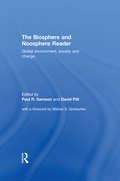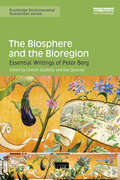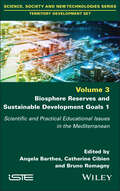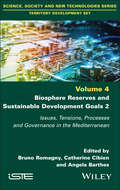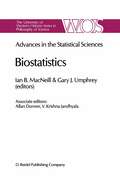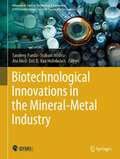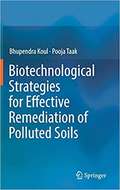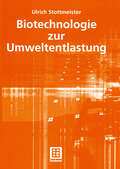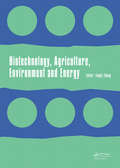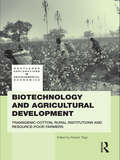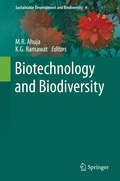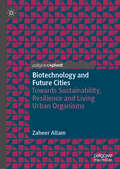- Table View
- List View
The Biosphere and Noosphere Reader: Global Environment, Society and Change
by Paul R. Samson David PittThe Reader is the first comprehensive history of the noosphere and biosphere. Drawing on classical influences, modern parallels, and insights into the future, the Reader traces the emergence of noosphere and biosphere concepts within the concept of environmental change. Reproducing material from seminla works, both past and present, key ideas and writings of prominent thinkers are presented, including Bergson, Vernadsky, Lovelock, Russell, Needham, Huxley, Medawar, Toynbee and Boulding, and extensive introductory pieces bu the editors drawattention to common themes and competing ideas. Focussing on issues of origins, theories, parallels and potential, the discussions place issues in a broad context, compare and contrast central concepts with those of the Gaia hypothesis, sustainability and global change, and examine the potential application of noospheric ideas to current debates about culture, education and technology in such realms as the Internet, space exploration, and the emergence of super-consciousness. Literally the `sphere of mind or intellect', the noosphere is aprt of the `realm of the possible' in human affairs, where there is a conscious effort to tackle global issues The noosphere concept captures a number of key contemporary issues - social evolution, global ecology, Gaia, deep ecology and global environmental change - contributing to ongoing debates concerning the implications of emerging technologies.
The Biosphere and the Bioregion: Essential Writings of Peter Berg (Routledge Environmental Humanities)
by Cheryll Glotfelty Eve QuesnelBioregionalism asks us to reimagine ourselves and the places where we live in ecological terms and to harmonize human activities with the natural systems that sustain life. As one of the originators of the concept of bioregionalism, Peter Berg (1937-2011) is a founding figure of contemporary environmental thought. The Biosphere and the Bioregion: Essential Writings of Peter Berg introduces readers to the biospheric vision and post-environmental genius of Berg. From books and essays to published interviews, this selection of writings represents Berg's bioregional vision and its global, local, urban, and rural applications. The Biosphere and the Bioregion provides a highly accessible introduction to bioregional philosophy, making Berg's paradigm available as a guiding vision and practical "greenprint" for the twenty-first century. This valuable compilation lays the groundwork for future research by offering the first-ever comprehensive bibliography of Berg's publications and should be of interest to students and scholars in the interdisciplinary fields of environmental humanities, environment and sustainability studies, as well as political ecology, environmental sociology and anthropology.
The Biosphere and the Bioregion: Essential Writings of Peter Berg (Routledge Environmental Humanities)
by Cheryll Glotfelty Eve QuesnelBioregionalism asks us to reimagine ourselves and the places where we live in ecological terms and to harmonize human activities with the natural systems that sustain life. As one of the originators of the concept of bioregionalism, Peter Berg (1937-2011) is a founding figure of contemporary environmental thought. The Biosphere and the Bioregion: Essential Writings of Peter Berg introduces readers to the biospheric vision and post-environmental genius of Berg. From books and essays to published interviews, this selection of writings represents Berg's bioregional vision and its global, local, urban, and rural applications. The Biosphere and the Bioregion provides a highly accessible introduction to bioregional philosophy, making Berg's paradigm available as a guiding vision and practical "greenprint" for the twenty-first century. This valuable compilation lays the groundwork for future research by offering the first-ever comprehensive bibliography of Berg's publications and should be of interest to students and scholars in the interdisciplinary fields of environmental humanities, environment and sustainability studies, as well as political ecology, environmental sociology and anthropology.
Biosphere-Atmosphere Exchange of Pollutants and Trace Substances: Experimental and Theoretical Studies of Biogenic Emissions and of Pollutant Deposition (Transport and Chemical Transformation of Pollutants in the Troposphere #4)
by SjaakSlaninaThe biosphere is the ultimate sink for air pollutants and is also the source of many precursors for the formation of photo-oxidants. In any analysis of air pollution and for determining source-receptor relationships, reliable emission and pollutant concentrations or depositions must be taken into account, together with their interactions between the atmosphere and the biosphere. This book presents a number of authoritative review articles covering topics which include biosphere-atmosphere exchange of ammonia, nitrogen oxides, ozone and sulfur-containing gases, the biological mechanisms involved in the exchange of trace gases, as well as generalizations of deposition over Europe.
Biosphere Reserves and Sustainable Development Goals 1: Scientific and Practical Educational Issues in the Mediterranean
by Angela Barthes Catherine Cibien Bruno RomagnySince 1971, UNESCO's Man and the Biosphere (MAB) Programme has embraced a number of principles that link the political, scientific and academic spheres. Biosphere Reserves and Sustainable Development Goals 1 presents these areas as privileged spaces for experimenting with operating methods specific to cross-cutting objectives and issues. These areas encourage the development of interdisciplinary research, supported by a worldwide network to disseminate experience, approaches and knowhow. The various global and local political scales are linked here, with different consequences for the reconfiguration of local political arenas, for specific modes of development linked to a renewed relationship with knowledge, powers and institutions, and for renewed relationships between the worlds of science, education and territorial governance.
Biosphere Reserves and Sustainable Development Goals 1: Scientific and Practical Educational Issues in the Mediterranean
by Angela Barthes Catherine Cibien Bruno RomagnySince 1971, UNESCO's Man and the Biosphere (MAB) Programme has embraced a number of principles that link the political, scientific and academic spheres. Biosphere Reserves and Sustainable Development Goals 1 presents these areas as privileged spaces for experimenting with operating methods specific to cross-cutting objectives and issues. These areas encourage the development of interdisciplinary research, supported by a worldwide network to disseminate experience, approaches and knowhow. The various global and local political scales are linked here, with different consequences for the reconfiguration of local political arenas, for specific modes of development linked to a renewed relationship with knowledge, powers and institutions, and for renewed relationships between the worlds of science, education and territorial governance.
Biosphere Reserves and Sustainable Development Goals 2: Issues, Tensions, Processes and Governance in the Mediterranean
by Bruno Romagny Catherine Cibien Angela BarthesSince 1971, UNESCO's Man and the Biosphere (MAB) Programme has embraced a number of principles that link the political, scientific and academic spheres. Biosphere Reserves and Sustainable Development Goals 2 is a reminder of the fundamental issues involved in governance. The diversity and multiplicity of stakeholders, and the complexity of the interplay between them, as well as their organization, are decisive factors in the proper management of resources and territories. The book also presents a number of case studies demonstrating that, between the strong development aspirations of their populations, the impact of human activities and the need to conserve their biological heritage, the biosphere reserves of the southern Mediterranean are facing major issues: agricultural pollution, forest fires, water use in a context of climate change, etc.
Biosphere Reserves and Sustainable Development Goals 2: Issues, Tensions, Processes and Governance in the Mediterranean
by Bruno Romagny Catherine Cibien Angela BarthesSince 1971, UNESCO's Man and the Biosphere (MAB) Programme has embraced a number of principles that link the political, scientific and academic spheres. Biosphere Reserves and Sustainable Development Goals 2 is a reminder of the fundamental issues involved in governance. The diversity and multiplicity of stakeholders, and the complexity of the interplay between them, as well as their organization, are decisive factors in the proper management of resources and territories. The book also presents a number of case studies demonstrating that, between the strong development aspirations of their populations, the impact of human activities and the need to conserve their biological heritage, the biosphere reserves of the southern Mediterranean are facing major issues: agricultural pollution, forest fires, water use in a context of climate change, etc.
Biostatistics: Advances in Statiscal Sciences Festschrift in Honor of Professor V.M. Joshi’s 70th Birthday Volume V (The Western Ontario Series in Philosophy of Science #38)
by I. B. MacNeill G. UmphreyOn May 27-31, 1985, a series of symposia was held at The University of Western Ontario, London, Canada, to celebrate the 70th birthday of Pro fessor V. M. Joshi. These symposia were chosen to reflect Professor Joshi's research interests as well as areas of expertise in statistical science among faculty in the Departments ofStatistical and Actuarial Sciences, Economics, Epidemiology and Biostatistics, and Philosophy. From these symposia, the six volumes which comprise the "Joshi Festschrift" have arisen. The 117 articles in this work reflect the broad interests and high quality of research of those who attended our conference. We would like to thank all of the contributors for their superb cooperation in helping us to complete this project. Our deepest gratitude must go to the three people who have spent so much of their time in the past year typing these volumes: Jackie Bell, Lise Constant, and Sandy Tarnowski. This work has been printed from "camera ready" copy produced by our Vax 785 computer and QMS Lasergraphix printers, using the text processing software TEX. At the initiation of this project, we were neophytes inthe use ofthis system. Thank you, Jackie, Lise, and Sandy, for having the persistence and dedication needed to complete this undertaking.
Biostimulants for Crop Production and Sustainable Agriculture
by Mirza Hasanuzzaman Barbara Hawrylak-Nowak Tofazzal Islam Masayuki FujitaAgricultural biostimulants are a group of substances or microorganisms, based on natural resources, that are applied to plants or soils to improve nutrient uptake and plant growth, and provide better tolerance to various stresses. Their function is to stimulate the natural processes of plants, or to enrich the soil microbiome to improve plant growth, nutrition, abiotic and/or biotic stress tolerance, yield and quality of crop plants. Interest in plant biostimulants has been on the rise over the past 10 years, driven by the growing interest of researchers and farmers in environmentally-friendly tools for improved crop performance. Focusing on recent progress on biostimulants and their role in crop production and agricultural sustainability, this book includes: 31 chapters on a wide range of biostimulants and their role in plant growth stimulation and stress tolerance. Mechanism of actions of diverse groups of biostimulants, such as trace elements, plant and seaweed extracts, humic substances, polyamines, osmolytes, vitamins, nanoparticles and microorganisms. New promising biostimulants with novel modes of action. Improved crop production technologies are urgently needed to meet the growing demand for food for the ever-increasing global population by addressing the impacts of changing climate on agriculture. This book is of interest to researchers in agriculture, agronomy, crop and plant science, soil science and environmental science.
Biotechnological Innovations in the Mineral-Metal Industry (Advances in Science, Technology & Innovation)
by Sandeep Panda Srabani Mishra Ata Akcil Eric D. Van HullebuschThe book presents the most advanced biotechnological information with respect to microbial applications in the treatment of mineral-metal bearing wastes. With growing interest in practical industrial applications of biomining microbes, of late, a lot of research has been devoted towards exploring their biotechnological potential for processing wastes derived from both primary and secondary resources for metal recovery. The chapters in the book present compiled information on several aspects of this exciting area of mineral biotechnology, that include fundamental, applied, bioprocess engineering and environment in separate chapters. These chapters provide updated information on the microbe-mineral interactions; resource specific bioleaching covering base, precious and rare earth elements leaching from primary and/or secondary resources; processing of leach solutions through biosorption, biomineralization, bio-electrochemical systems for resource recovery; treatment of mine waters, engineering and scale-up aspects of bioreactor systems for bioleaching of specific wastes and environmental challenges related to bio-mining. The book provides a unique platform for the dissemination of the state-of-the-art research on mineral biotechnology and serves as a bridge between academia and industry. Authored by well-renowned experts, it is an appropriate reference for graduate students, scientists, engineers, environmentalists working in the area of mineral biotechnology and industrial technologies.
Biotechnological Strategies for Effective Remediation of Polluted Soils
by Bhupendra Koul Pooja TaakThis book presents a comprehensive collection of various in situ and ex-situ soil remediation regimes that employ natural or genetically modified microbes, plants, and animals for the biodegradation of toxic compounds or hazardous waste into simpler non-toxic products. These techniques are demonstrated to be functionally effective in connection with physical, chemical, and biological strategies. Soil and water contamination through heavy metals, hydrocarbons and radioactive wastes is of global concern, as these factors have cumulative effects on the environment and human health through food-chain contamination. The book discusses the utilization of algae, plants, plant-associated bacteria, fungi (endophytic or rhizospheric) and certain lower animals for the sustainable bioremediation of organic and inorganic pollutants. In addition, it explores a number of more recent techniques like biochar and biofilms for carbon sequestration, soil conditioning and remediation, and water remediation. It highlights a number of recent advances in nanobioremediation, an emerging technology based on biosynthetic nanoparticles. Lastly, it presents illustrative case studies and highlights the successful treatment of polluted soils by means of these strategies.
Biotechnologie zur Umweltentlastung (Teubner-Reihe Umwelt)
by Ulrich StottmeisterBiotechnologische Verfahren nehmen einen wichtigen Platz bei der Entlastung der Umwelt ein. Die natürlichen Prozesse der Selbstreinigung sowie deren zielgerichtete Nutzung und Beeinflussung stehen im Mittelpunkt dieses Lehrbuches. Die präventive Anwendung biotechnologischer Prozesse in Produktionslinien sowie ökologische Gesamtbilanzen gewinnen zunehmend an Bedeutung.
Biotechnologies and Genetics in Plant Mutation Breeding: Volume 2: Revolutionizing Plant Biology
by Tariq Ahmad Bhat Khalid Rehman Hakeem"An indispensable source for researchers, teachers, and graduate and postgraduate students interested in mutation breeding and genetic engineering. It introduces readers to contemporary knowledge and state-of-the-art technologies in the field of mutation breeding, including fundamental mechanisms and applications. . . . It will provide new directions, and avenues for enhancement of food security and food quality by using the latest techniques for the 'mutation as breeding' approach." - From Prof. Jameel M. Al-Khayri, King Faisal University, Saudi Arabia This comprehensive three-volume set book aims to help combat the challenge of providing enough food for the world by the use of advanced genetic processes to improve crop production, both in quantity and quality. Volume 1: Mutagenesis and Crop Improvement discusses mutagenesis, cytotoxicity, and crop improvement, covering the processes, mutagenic effectiveness, and mechanisms. The volume emphasizes the improvement of agronomic characteristics by manipulating the genotype of plant species, resulting in increased productivity. Volume 2: Revolutionizing Plant Biology covers the use of mutagenesis and biotechnology to explore the variability of mutant genes for crop improvement. The chapters deal with in-vitro mutagenesis to exploit the somaclonal variations induced in cell culture and highlight the importance of in-vitro mutagenesis in inducing salt resistance, heat resistance, and drought resistance. Volume 3: Mechanisms for Genetic Manipulation of Plants and Plant Mutants reviews the genetic engineering techniques used to mutate genes and to incorporate them into different plant species of cereals, pulses, vegetables, and fruits. Also discussed are the principles of genetic engineering by which desired genes can be transferred from plants to animals to microorganisms and vice versa.
Biotechnologies and Genetics in Plant Mutation Breeding: Volume 3: Mechanisms for Genetic Manipulation of Plants and Plant Mutants
by Tariq Ahmad Bhat Khalid Rehman Hakeem"An indispensable source for researchers, teachers, and graduate and postgraduate students interested in mutation breeding and genetic engineering. It introduces readers to contemporary knowledge and state-of-the-art technologies in the field of mutation breeding, including fundamental mechanisms and applications. . . . It will provide new directions, and avenues for enhancement of food security and food quality by using the latest techniques for the 'mutation as breeding' approach." - From Prof. Jameel M. Al-Khayri, King Faisal University, Saudi Arabia This comprehensive three-volume set book aims to help combat the challenge of providing enough food for the world by the use of advanced genetic processes to improve crop production, both in quantity and quality. Volume 1: Mutagenesis and Crop Improvement discusses mutagenesis, cytotoxicity, and crop improvement, covering the processes, mutagenic effectiveness, and mechanisms. The volume emphasizes the improvement of agronomic characteristics by manipulating the genotype of plant species, resulting in increased productivity. Volume 2: Revolutionizing Plant Biology covers the use of mutagenesis and biotechnology to explore the variability of mutant genes for crop improvement. The chapters deal with in-vitro mutagenesis to exploit the somaclonal variations induced in cell culture and highlight the importance of in-vitro mutagenesis in inducing salt resistance, heat resistance, and drought resistance. Volume 3: Mechanisms for Genetic Manipulation of Plants and Plant Mutants reviews the genetic engineering techniques used to mutate genes and to incorporate them into different plant species of cereals, pulses, vegetables, and fruits. Also discussed are the principles of genetic engineering by which desired genes can be transferred from plants to animals to microorganisms and vice versa.
Biotechnologies and Genetics in Plant Mutation Breeding: Volume 1: Mutagenesis and Crop Improvement
by Tariq Ahmad Bhat Khalid Rehman Hakeem"An indispensable source for researchers, teachers, and graduate and postgraduate students interested in mutation breeding and genetic engineering. It introduces readers to contemporary knowledge and state-of-the-art technologies in the field of mutation breeding, including fundamental mechanisms and applications. . . . It will provide new directions, and avenues for enhancement of food security and food quality by using the latest techniques for the 'mutation as breeding' approach." - From Prof. Jameel M. Al-Khayri, King Faisal University, Saudi Arabia This comprehensive three-volume set book aims to help combat the challenge of providing enough food for the world by the use of advanced genetic processes to improve crop production, both in quantity and quality. Volume 1: Mutagenesis and Crop Improvement discusses mutagenesis, cytotoxicity, and crop improvement, covering the processes, mutagenic effectiveness, and mechanisms. The volume emphasizes the improvement of agronomic characteristics by manipulating the genotype of plant species, resulting in increased productivity. Volume 2: Revolutionizing Plant Biology covers the use of mutagenesis and biotechnology to explore the variability of mutant genes for crop improvement. The chapters deal with in-vitro mutagenesis to exploit the somaclonal variations induced in cell culture and highlight the importance of in-vitro mutagenesis in inducing salt resistance, heat resistance, and drought resistance. Volume 3: Mechanisms for Genetic Manipulation of Plants and Plant Mutants reviews the genetic engineering techniques used to mutate genes and to incorporate them into different plant species of cereals, pulses, vegetables, and fruits. Also discussed are the principles of genetic engineering by which desired genes can be transferred from plants to animals to microorganisms and vice versa.
Biotechnologies and Genetics in Plant Mutation Breeding: Volume 1: Mutagenesis and Crop Improvement
"An indispensable source for researchers, teachers, and graduate and postgraduate students interested in mutation breeding and genetic engineering. It introduces readers to contemporary knowledge and state-of-the-art technologies in the field of mutation breeding, including fundamental mechanisms and applications. . . . It will provide new directions, and avenues for enhancement of food security and food quality by using the latest techniques for the 'mutation as breeding' approach." - From Prof. Jameel M. Al-Khayri, King Faisal University, Saudi Arabia This comprehensive three-volume set book aims to help combat the challenge of providing enough food for the world by the use of advanced genetic processes to improve crop production, both in quantity and quality. Volume 1: Mutagenesis and Crop Improvement discusses mutagenesis, cytotoxicity, and crop improvement, covering the processes, mutagenic effectiveness, and mechanisms. The volume emphasizes the improvement of agronomic characteristics by manipulating the genotype of plant species, resulting in increased productivity. Volume 2: Revolutionizing Plant Biology covers the use of mutagenesis and biotechnology to explore the variability of mutant genes for crop improvement. The chapters deal with in-vitro mutagenesis to exploit the somaclonal variations induced in cell culture and highlight the importance of in-vitro mutagenesis in inducing salt resistance, heat resistance, and drought resistance. Volume 3: Mechanisms for Genetic Manipulation of Plants and Plant Mutants reviews the genetic engineering techniques used to mutate genes and to incorporate them into different plant species of cereals, pulses, vegetables, and fruits. Also discussed are the principles of genetic engineering by which desired genes can be transferred from plants to animals to microorganisms and vice versa.
Biotechnologies and Genetics in Plant Mutation Breeding: Volume 2: Revolutionizing Plant Biology
"An indispensable source for researchers, teachers, and graduate and postgraduate students interested in mutation breeding and genetic engineering. It introduces readers to contemporary knowledge and state-of-the-art technologies in the field of mutation breeding, including fundamental mechanisms and applications. . . . It will provide new directions, and avenues for enhancement of food security and food quality by using the latest techniques for the 'mutation as breeding' approach." - From Prof. Jameel M. Al-Khayri, King Faisal University, Saudi Arabia This comprehensive three-volume set book aims to help combat the challenge of providing enough food for the world by the use of advanced genetic processes to improve crop production, both in quantity and quality. Volume 1: Mutagenesis and Crop Improvement discusses mutagenesis, cytotoxicity, and crop improvement, covering the processes, mutagenic effectiveness, and mechanisms. The volume emphasizes the improvement of agronomic characteristics by manipulating the genotype of plant species, resulting in increased productivity. Volume 2: Revolutionizing Plant Biology covers the use of mutagenesis and biotechnology to explore the variability of mutant genes for crop improvement. The chapters deal with in-vitro mutagenesis to exploit the somaclonal variations induced in cell culture and highlight the importance of in-vitro mutagenesis in inducing salt resistance, heat resistance, and drought resistance. Volume 3: Mechanisms for Genetic Manipulation of Plants and Plant Mutants reviews the genetic engineering techniques used to mutate genes and to incorporate them into different plant species of cereals, pulses, vegetables, and fruits. Also discussed are the principles of genetic engineering by which desired genes can be transferred from plants to animals to microorganisms and vice versa.
Biotechnologies and Genetics in Plant Mutation Breeding: Volume 3: Mechanisms for Genetic Manipulation of Plants and Plant Mutants
"An indispensable source for researchers, teachers, and graduate and postgraduate students interested in mutation breeding and genetic engineering. It introduces readers to contemporary knowledge and state-of-the-art technologies in the field of mutation breeding, including fundamental mechanisms and applications. . . . It will provide new directions, and avenues for enhancement of food security and food quality by using the latest techniques for the 'mutation as breeding' approach." - From Prof. Jameel M. Al-Khayri, King Faisal University, Saudi Arabia This comprehensive three-volume set book aims to help combat the challenge of providing enough food for the world by the use of advanced genetic processes to improve crop production, both in quantity and quality. Volume 1: Mutagenesis and Crop Improvement discusses mutagenesis, cytotoxicity, and crop improvement, covering the processes, mutagenic effectiveness, and mechanisms. The volume emphasizes the improvement of agronomic characteristics by manipulating the genotype of plant species, resulting in increased productivity. Volume 2: Revolutionizing Plant Biology covers the use of mutagenesis and biotechnology to explore the variability of mutant genes for crop improvement. The chapters deal with in-vitro mutagenesis to exploit the somaclonal variations induced in cell culture and highlight the importance of in-vitro mutagenesis in inducing salt resistance, heat resistance, and drought resistance. Volume 3: Mechanisms for Genetic Manipulation of Plants and Plant Mutants reviews the genetic engineering techniques used to mutate genes and to incorporate them into different plant species of cereals, pulses, vegetables, and fruits. Also discussed are the principles of genetic engineering by which desired genes can be transferred from plants to animals to microorganisms and vice versa.
Biotechnology, Agriculture, Environment and Energy: Proceedings of the 2014 International Conference on Biotechnology, Agriculture, Environment and Energy (ICBAEE 2014), May 22-23, 2014, Beijing, China.
by Fangli ZhengThe 2014 International Conference on Biotechnology, Agriculture, Environment and Energy (ICBAEE 2014) was held May 22-23, 2014 in Beijing, China. The objective of ICBAEE 2014 was to provide a platform for researchers, engineers, academics as well as industry professionals from all over the world to present their research results and development act
Biotechnology and Agricultural Development: Transgenic Cotton, Rural Institutions and Resource-poor Farmers (Routledge Explorations in Environmental Economics)
by Rob TrippThis book addresses the continuing controversy over the potential impact of genetically modified (GM) crops in developing countries. Supporters of the technology claim it offers one of the best hopes for increasing agricultural production and reducing rural poverty, while opponents see it as an untested intervention that will bring corporate control of peasant farming. The book examines the issues by reviewing the experience of GM, insect-resistant cotton, the most widely grown GM crop in developing countries. The book begins with an introduction to agricultural biotechnology, a brief examination of the history of cotton production technology (and the institutions required to support that technology), and a thorough review of the literature on the agronomic performance of GM cotton. It then provides a review of the economic and institutional outcomes of GM cotton during the first decade of its use. The core of the book is four country case studies based on original fieldwork in the principal developing countries growing GM cotton (China, India, South Africa and Colombia). The book concludes with a summary of the experience to date and implications for the future of GM crops in developing countries. This review challenges those who have predicted technological failure by describing instances in which GM cotton has proven useful and has been enthusiastically taken up by smallholders. But it also challenges those who claim that biotechnology can take the lead in agricultural development by examining the precarious institutional basis on which these hopes rest in most countries. The analysis shows how biotechnology’s potential contribution to agricultural development must be seen as a part of (and often secondary to) more fundamental policy change. The book should be of interest to a wide audience concerned with agricultural development. This would include academics in the social and agricultural sciences, donor agencies and NGOs.
Biotechnology and Agricultural Development: Transgenic Cotton, Rural Institutions and Resource-poor Farmers (Routledge Explorations in Environmental Economics)
by Robert TrippThis book addresses the continuing controversy over the potential impact of genetically modified (GM) crops in developing countries. Supporters of the technology claim it offers one of the best hopes for increasing agricultural production and reducing rural poverty, while opponents see it as an untested intervention that will bring corporate control of peasant farming. The book examines the issues by reviewing the experience of GM, insect-resistant cotton, the most widely grown GM crop in developing countries. The book begins with an introduction to agricultural biotechnology, a brief examination of the history of cotton production technology (and the institutions required to support that technology), and a thorough review of the literature on the agronomic performance of GM cotton. It then provides a review of the economic and institutional outcomes of GM cotton during the first decade of its use. The core of the book is four country case studies based on original fieldwork in the principal developing countries growing GM cotton (China, India, South Africa and Colombia). The book concludes with a summary of the experience to date and implications for the future of GM crops in developing countries. This review challenges those who have predicted technological failure by describing instances in which GM cotton has proven useful and has been enthusiastically taken up by smallholders. But it also challenges those who claim that biotechnology can take the lead in agricultural development by examining the precarious institutional basis on which these hopes rest in most countries. The analysis shows how biotechnology’s potential contribution to agricultural development must be seen as a part of (and often secondary to) more fundamental policy change. The book should be of interest to a wide audience concerned with agricultural development. This would include academics in the social and agricultural sciences, donor agencies and NGOs.
Biotechnology and Biodiversity: Biology, Biotechnology And Applications (Sustainable Development and Biodiversity #4)
by M. R. Ahuja K. G. RamawatThe purpose of this book is to assess the potential effects of biotechnological approaches particularly genetic modification on biodiversity and the environment. All aspects of biodiversity such as ecological diversity, species diversity and genetic diversity are considered. Higher organisms contain a specific set of linear DNA molecules called chromosomes and a complete set of chromosomes in an organism comprises its genome. The collection of traits displayed by any organism (phenotype) depends on the genes present in its genome (genotype). The appearance of any specific trait also will depend on many other factors, including whether the gene(s) responsible for the trait is/are turned on (expressed) or off, the specific cells within which the genes are expressed and how the genes, their expression and the gene products interact with environmental factors. The primary biotechnology which concerns us is that of genetic manipulation, which has a direct impact on biodiversity at the genetic level. By these manipulations, novel genes or gene fragments can be introduced into organisms (creating transgenics) or existing genes within an organism can be altered. Transgenics are a major area of concern, combining genes from different species to effectively create novel organisms. Current rates of disappearance of biological and cultural diversity in the world are unprecedented. Intensive resource exploitation due to social and economic factors has led to the destruction, conversion or degradation of ecosystems. Reversing these trends requires time to time assessment to integrate conservation and development.
Biotechnology and Future Cities: Towards Sustainability, Resilience and Living Urban Organisms
by Zaheer AllamThis book explores how biotechnology can lead to the reimagination of cities. In a time where the increasing adoption of technology by cities is leading to unsustainable environmental and economic concerns, biotechnology has enabled new ways of envisioning data and energy storage. Zaheer Allam thus revisits the popular concept of Smart Cities -and its associated Internet of Things (IoT) to explore how the biological sciences, coupled with technology, can be applied to cities; and in doing so, create living urban organisms on an unprecedented scale. This new concept will open up exciting avenues to providing novel solutions for climate change mitigation. The book goes on to address various potential concerns and discusses what regulatory frameworks would be needed to safely implement such a concept. It will be a useful tool for planners, policy makers and engineers as well as for researchers with in interest in the future of our cities.
Biotechnology And The New Agricultural Revolution
by Joseph J MolnarThe advent of new methods in shaping the performance characteristics of plants, animals, and microbes dramatically expands the possibilities for advances in agriculture -- a new "Green Revolution" in the offing. This book examines the impact of such developments on agricultural institutions, agribusiness, and farmers: What happens when a fundamenta
